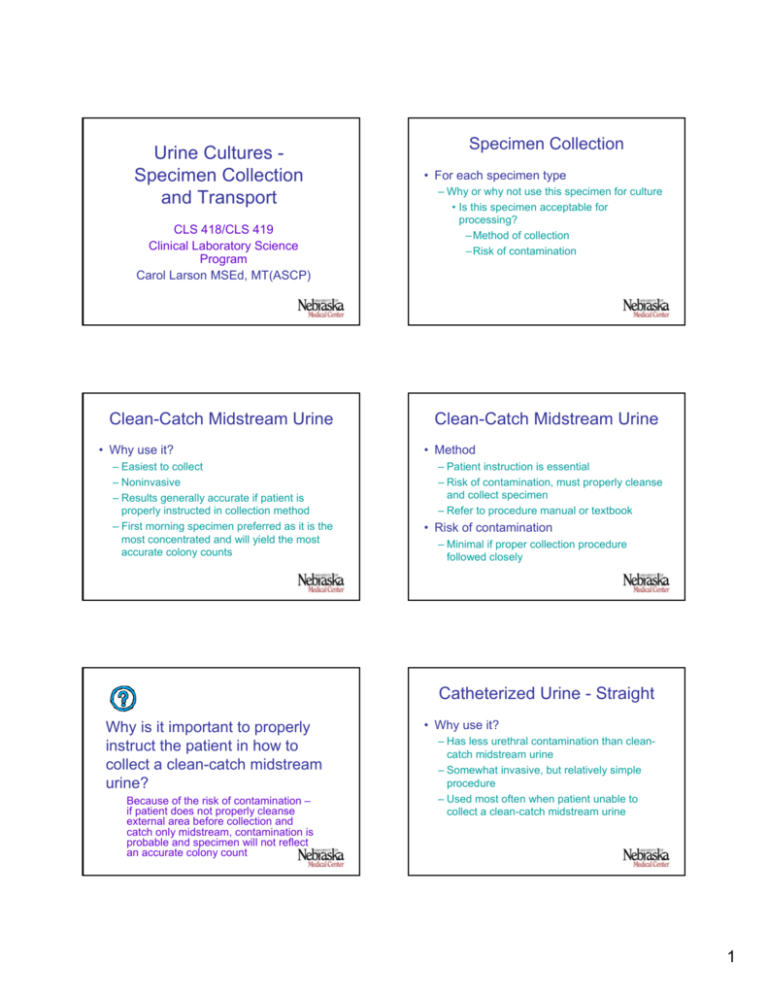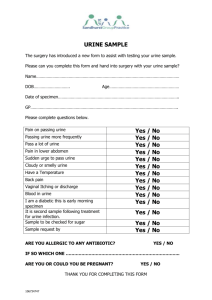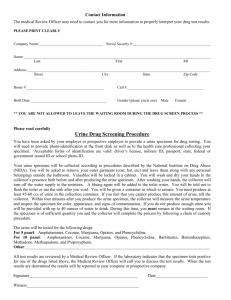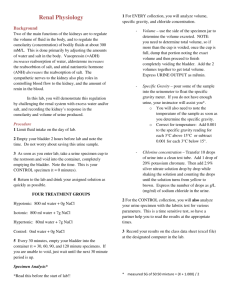Urine Cultures - Specimen Collection and Transport
advertisement

Urine Cultures Specimen Collection and Transport CLS 418/CLS 419 Clinical Laboratory Science Program Carol Larson MSEd, MT(ASCP) Clean-Catch Midstream Urine • Why use it? – Easiest to collect – Noninvasive – Results generally accurate if patient is properly instructed in collection method – First morning specimen preferred as it is the most concentrated and will yield the most accurate colony counts Specimen Collection • For each specimen type – Why or why not use this specimen for culture • Is this specimen acceptable for processing? –Method of collection –Risk of contamination Clean-Catch Midstream Urine • Method – Patient instruction is essential – Risk of contamination, must properly cleanse and collect specimen – Refer to procedure manual or textbook • Risk of contamination – Minimal if proper collection procedure followed closely Catheterized Urine - Straight Why is it important to properly instruct the patient in how to collect a clean-catch midstream urine? Because of the risk of contamination – if patient does not properly cleanse external area before collection and catch only midstream, contamination is probable and specimen will not reflect an accurate colony count • Why use it? – Has less urethral contamination than cleancatch midstream urine – Somewhat invasive, but relatively simple procedure – Used most often when patient unable to collect a clean-catch midstream urine 1 Catheterized Urine - Straight • Method – Requires trained staff to perform collection – Refer to procedure manual or textbook • Risk of contamination When is it appropriate to collect a straight catheterized urine? – Urine will have less urethral contamination than clean-catch midstream urine – Catheter can introduce bacteria into the bladder as it passes through urethra When the patient is unable to collect a clean-catch midstream urine (i.e. pediatric or elderly patient) Catheterized Urine - Indwelling Catheterized Urine - Indwelling • Why use it? – Patient already has catheter in place – Catheter is often the source of infection – Use only when patient is ill • Method – Do not collect urine from collection bag – Use scrupulous aseptic technique – Refer to procedure manual or textbook • Risk of contamination – Urine will have less urethral contamination than clean-catch midstream urine – Must be freshly voided urine, not what has been in collection bag Suprapubic Aspiration Urine • Why use it? Why is it NOT appropriate to collect urine from an indwelling catheter collection bag? Urine has sit at room temperature for an extended period of time and any organisms present will proliferate giving falsely increased colony count – Definitive method for collectign uncontaminated specimens – Very invasive – Used with pediatric patients or when interpretation of voided clean catch urine is difficult to interpret – Only collection method acceptable if culturing for anaerobic organisms • Urine in syringe is protected from air! • Avoids urethra which is colonized with anaerobes 2 Suprapubic Aspiration Urine • Method – Urine withdrawn through a pericutaneously inserted needle into the bladder – Refer to procedure manual or textbook • Risk of contamination – No contamination if aseptic procedure followed – Transient colonization of bladder can occur Random Voided Urine • Why not use it? – Normal urogenital flora can easily contaminate the voided urine – Colony count would be increased due to contamination and not reflect what is in the bladder If a suprapubic urine culture has a low colony count, should it be treated as contamination? Why or why not? No! Growth of any kind in a suprapubic urine should be treated as a potential pathogen because the collection procedure utilizes sterile technique and urine in the bladder normally is sterile. 24-Hour Urine Collection • Why not use it? – Urine is an excellent culture media for bacteria – Contaminants and pathogens alike will proliferate as they sit in a 24-hour urine leading to erroneous culture results • I.e. higher than actual colony counts Specimen Handling & Transport What two specimen types must NEVER be used for a urine culture? Random voided urine and a 24-hour urine • Ideally, specimen should be transported to laboratory within 30 minutes of collection • Container – Sterile, leak-proof container placed within a sealable, leak-proof, plastic bag with separate section for paperwork – Label with patient name, ID number, location, collection method, collection time 3 Specimen Handling & Transport – Time & Temperature – Culture must be setup within 2 hours after collection if keep at room temperature – Specimen can be refrigerated at 4ºC for up to 24 hours if there is a delay in setting up the culture – Transport media • Use if there is a delay in transporting specimen to lab • Place specimen in transport medium; i.e. boric acid • Boric acid will maintain appropriate colony count for up to 24 hours at room temperature • Other transports available, check package inserts for correct procedure Specimen Handling & Transport • Specimen must be assessed for acceptability upon arrival in laboratory • Criteria: – Proper container and label – Time of collection within limits – Stored at proper temperature – Appropriate collection method – Volume (quantity) of urine adequate for culture Screening Procedures What criteria must be adhered to when transporting to and receiving in the lab a urine specimen for culture? Proper container, label, collection method, time between collection and culture setup, storage, and volume • 60-80% of urine cultures received in the laboratory will be “no growth” or “growth of contaminants only” • Urine dipstick: – Nitrite test: detect bacteria able to convert nitrate to nitrite – Leukocyte esterase test: detect WBC’s Screening Procedures • Gram stain – Easy, inexpensive, most sensitive, reliable – Method • One drop uncentrifuged urine on slide, dry, stain, evaluate – Results • One organism per oil immersion field correlates with 105 cfu/ml; PMN quantitation not reliable – Most labs do not do gram stains on urine What three tests are often used to screen urine for potential bacterial infection? Nitrite and Leukocyte esterase on dipstick, and gram stain • Due to high number of negative results, and • Too labor intensive with number of cultures done per day 4 Review • Urine collection methods Which screening test is the most sensitive? Gram stain – Why/why not use, method, risk of contamination • Specimen handling and transport – Container, time, temperature, criteria for accepting specimen in lab • Screening procedures – Nitrite, leukocyte esterase, gram stain References: • Mahon, C.R., Lehman, D.C. & Manuselis, G., Textbook of Diagnostic Microbiology, 3rd Ed., Saunders Elsevier, 2007. 5







